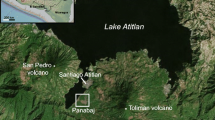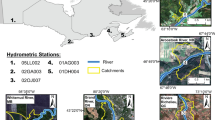Abstract
In this study, we present a geographical information system (GIS)-based approach to enable the estimation of lahar features important to rapid hazard assessment (including flow routes, velocities and travel times). Our method represents a simplified first stage in extending the utility of widely used existing GIS-based inundation models, such as LAHARZ, to provide estimates of flow speeds. LAHARZ is used to determine the spatial distribution of a lahar of constant volume, and for a given cell in a GIS grid, a single-direction flow routing technique incorporating the effect of surface roughness directs the flow according to steepest descent. The speed of flow passing through a cell is determined from coupling the flow depth, change in elevation and roughness using Manning’s formula, and in areas where there is little elevation difference, flow is routed to locally maximum increase in velocity. Application of this methodology to lahars on Montserrat, West Indies, yielded support for this GIS-based approach as a hazard assessment tool through tests on small volume (5,000–125,000 m3) dilute lahars (consistent with application of Manning’s law). Dominant flow paths were mapped, and for the first time in this study area, velocities (magnitudes and spatial distribution) and average travel times were estimated for a range of lahar volumes. Flow depth approximations were also made using (modified) LAHARZ, and these refined the input to Manning’s formula. Flow depths were verified within an order of magnitude by field observations, and velocity predictions were broadly consistent with proxy measurements and published data. Forecasts from this coupled method can operate on short to mid-term timescales for hazard management. The methodology has potential to provide a rapid preliminary hazard assessment in similar systems where data acquisition may be difficult.









Similar content being viewed by others
References
Acrement GJ, Schneider VR (1990) Guide for selecting Manning’s roughness coefficients for natural channels and floodplains. US Geol Surv Water Supply Pap 2339
Aguilera E, Pareschi MT, Rosi M, Zanchetta G (2004) Risk from lahars in the Northern Valleys of Cotopaxi Volcano (Ecuador). Nat Hazards 33:161–189. doi:10.1023/B:NHAZ.0000037037.03155.23
Alexander D (2007) Making research on geological hazards relevant to stakeholders’ needs. Quatern Int 171–172:186–192. doi:10.1016/j.quaint.2007.01.006
Alho P, Aaltonen J (2008) Comparing a 1D hydraulic model with a 2D hydraulic model for the simulation of extreme glacial outburst floods. Hydrol Process 22:1537–1547. doi:10.1002/hyp.6692
Alho P, Roberts MJ, Kayhko J (2007) Estimating the inundation area of a massive, hypothetical jokulhlaup from northwest Vatnajokull, Iceland. Nat Hazards 41:21–42. doi:10.1007/s11069-006-9007-z
Barclay J, Johnstone JE, Matthews AJ (2006) Meteorological monitoring of an active volcano: implications for eruption prediction. J Volcanol Geotherm Res 150:339–358. doi:10.1016/j.jvolgeores.2005.07.020
Barclay J, Alexander J, Susnik J (2007) Rainfall-induced lahars in the Belham Valley, Montserrat, West Indies. J Geol Soc London 164:815–827. doi:10.1144/0016-76492006-078
Bates PD, De Roo APJ (2000) A simple raster-based model for flood inundation simulation. J Hydrol 236:54–77. doi:10.1016/S0022-1694(00)00278-X
Brookes CJ, Hooke JM, Mant J (2000) Modelling vegetation interactions with channel flow in river valleys of the Mediterranean region. Catena 40:93–118. doi:10.1016/S0341-8162(99)00065-X
Bulmer MH, Barnouin-Jha OS, Peitersen MN, Bourke M (2002) An empirical approach to studying debris flows: implications for planetary modeling studies. J Geophys Res 107:5033. doi:10.1029/2001JE001531
Candela A, Noto LV, Aronica G (2005) Influence of surface roughness in hydrological response of semiarid catchments. J Hydrol 313:119–131. doi:10.1016/j.jhydrol.2005.01.023
Canuti P, Casagli N, Catani F, Falorni G (2002) Modeling the Guagua Pichincha volcano (Ecuador) lahars. Phys Chem Earth 27:1587–1599. doi:10.1016/S1474-7065(02)00180-8
Carrivick JL, Manville V, Cronin SJ (2009) A fluid dynamics approach to modelling the 18th March 2007 lahar at Mt. Ruapehu, New Zealand. Bull Volcanol 71:153–169. doi:10.1007/s00445-008-0213-2
Carrivick JL, Manville V, Graettinger A, Cronin SJ (2010) Coupled fluid dynamics-sediment transport modelling of a Crater Lake break-out lahar: Mt. Ruapehu, New Zealand. J Hydrol 388:399–413. doi:10.1016/j.jhydrol.2010.05.023
Caruso P, Pareschi MT (1993) Estimation of lahar and lahar-runout flow hydrograph on natural beds. Environ Geol 22:141–152. doi:10.1007/BF00789326
Chow VT (1959) Open channel hydraulics. McGraw-Hill, New York
Cronin SJ, Neall VE, Lecointre JA, Palmer AS (1999) Dynamic interactions between lahars and stream flow: a case study from Ruapehu Volcano, New Zealand. Geol Soc Am Bull 111:28–38. doi:10.1130/0016-7606(1999)111<0028:DIBLAS>2.3.CO;2
Darnell AR (2010) Application of geographical information systems to lahar hazard assessment on an active volcanic system. Ph.D. thesis, University of East Anglia, Norwich
Darnell AR, Lovett AL, Barclay J, Herd RA (2010) An application-driven approach to terrain model construction. Int J Geogr Inf Sci 24:1171–1191. doi:10.1080/13658810903318889
Darnell AR, Barclay J, Herd RA, Philips JC, Lovett AA, Cole PD (2012) Geographical information system approaches for hazard mapping of dilute lahars on Montserrat, West Indies. Bull Volcanol 74:1337–1353. doi:10.1007/s00445-012-0596-y
Davila N, Capra L, Gavilanes-Ruiz JC, Varley N, Norini G, Gomez Vazquez A (2007) Recent lahars at Volcan de Colima (Mexico): drainage variation and spectral classification. J Volcanol Geotherm Res 165:127–141. doi:10.1016/j.jvolgeores.2007.05.016
De Wolfe VG, Santi PM, Ey J, Gartner JE (2008) Effective mitigation of debris flows at Lemon Dam, La Plata County, Colorado. Geomorphol 96:366–377. doi:10.1016/j.geomorph.2007.04.008
Doyle EE, Cronin SJ, Cole SE, Thouret J-C (2010) The coalescence and organization of lahars at Semeru volcano, Indonesia. Bull Volcanol 72:961–970. doi:10.1007/s00445-010-0381-8
Fagents SA, Baloga SM (2006) Toward a model for bulking and debulking of lahars. J Geophys Res 111:B10201. doi:10.1029/2005JB003986
Gibbs D (1986) Montserrat. In: Scott DA, Carbonnell M (eds) A directory of neotropical wetlands. Page Bros, Norwich, pp 547–549
Gioia G, Bombardelli FA (2002) Scaling and similarity in rough channel flows. Phys Rev Lett 88:014501. doi:10.1103/PhysRevLett.88.014501
Hardy RJ (2006) Fluvial geomorphology. Prog Phys Geogr 30:553–567. doi:10.1191/0309133306pp498pr
Horn BKP (1981) Hill shading and the reflectance map. Proc IEEE 69:14–47
Horritt MS (2005) Parameterisation, validation and uncertainty analysis of CFD models of fluvial and flood hydraulics in the natural environment. In: Bates PD, Lane SN, Ferguson RI (eds) Computational fluid dynamics applications in environmental hydraulics. Wiley, Chichester, pp 193–213
Hubbard BE, Sheridan MF, Carrasco-Nunez G, Diaz-Castellon R, Rodriguez SR (2007) Comparative lahar hazard mapping at Volcan Citlaltepetl, Mexico using SRTM, ASTER and DTED-1 digital topographic data. J Volcanol Geotherm Res 160:99–124. doi:10.1016/j.jvolgeores.2006.09.005
Huebl J, Fiebiger G (2005) Debris-flow mitigation measures. In: Jakob M, Hungr O (eds) Debris-flow hazards and related phenomena. Springer, Berlin, pp 445–488
Huggel C, Kaab A, Haeberli W, Krummenacher B (2003) Regional-scale GIS-models for assessment of hazards from glacier lake outburst: evaluation and application in the Swiss Alps. Nat Hazards Earth Syst Sci 3:647–662. doi:10.5194/nhess-3-647-2003
Huggel C, Schneider D, Julio Miranda P, Delgado Granados H, Kaab A (2008) Evaluation of ASTER and SRTM DEM data for lahar modelling: a case study on lahars from Popocatepetl Volcano, Mexico. J Volcanol Geotherm Res 170:99–110. doi:10.1016/j.jvolgeores.2007.09.005
Hungr O (2000) Analysis of debris flow surges using the theory of uniformly progressive flow. Earth Surf Process Landf 25:483–495. doi:10.1002/(SICI)1096-9837(200005)25:5<483::AID-ESP76>3.0.CO;2-Z
Iverson RM (1997) The physics of debris flows. Rev Geophys 35:245–296. doi:10.1029/97RG00426
Iverson RM, Schilling SP, Vallance JW (1998) Objective delineation of lahar-inundation hazard zones. Geol Soc Am Bull 110:972–984. doi:10.1130/0016-7606(1998)110<0972:ODOLIH>2.3.CO;2
Jones KH (1998) A comparison of algorithms used to compute hill slope as a property of the DEM. Comput Geosci 24:315–323. doi:10.1016/S0098-3004(98)00032-6
Laenen A, Hansen RP (1988) Simulation of three lahars in the Mount St. Helens area, Washington, using a one-dimensional, unsteady stream flow model. US Geol Surv Water-Resour Invest Rep 88-4004
Lavigne F, Thouret J-C (2002) Sediment transportation and deposition by rain-triggered lahars at Merapi Volcano, Central Java, Indonesia. Geomorphol 49:45–69. doi:10.1016/S0169-555X(02)00160-5
Liu YB, Gebremeskel S, De Smedt F, Hoffmann L, Pfister L (2003) A diffusive transport approach for flow routing in GIS-based flood modeling. J Hydrol 283:91–106. doi:10.1016/S0022-1694(03)00242-7
Macedonio G, Pareschi MT (1992) Numerical simulation of some lahars from Mount St. Helens. J Volcanol Geotherm Res 54:65–80. doi:10.1016/0377-0273(92)90115-T
McIntosh BS, Seaton RAF, Jeffrey P (2007) Tools to think with? Towards understanding the use of computer-based support tools in policy relevant research. Environ Modell Softw 22:640–648. doi:10.1016/j.envsoft.2005.12.015
Merz B, Friedrich J, Disse M, Schwarz J, Goldammer JG, Wachter J (2006) Possibilities and limitations of interdisciplinary, user-oriented research: experiences from the German Research Network Natural Disasters. Nat Hazards 38:3–20. doi:10.1007/s11069-005-8597-1
O’Callaghan JF, Mark DM (1984) The extraction of drainage networks from digital elevation data. Comput Vis Graph Image Process 28:328–344. doi:10.1016/S0734-189X(84)80011-0
Oramas Dorta D, Toyos G, Oppenheimer C, Pareschi MT, Sulpizio R, Zanchetta G (2007) Empirical modelling of the May 1998 small debris flows in Sarno (Italy) using LAHARZ. Nat Hazards 40:381–396. doi:10.1007/s11069-006-0035-5
Pierson TC (1995) Flow characteristics of large eruption-triggered debris flows at snow-clad volcanoes: constraints for debris-flow models. J Volcanol Geotherm Res 66:283–294. doi:10.1016/0377-0273(94)00070-W
Pitman EB, Patra A, Bauer A, Sheridan M, Bursik M (2003) Computing debris flows and landslides. Phys Fluids 15:3638–3646. doi:10.1063/1.1614253
Proctor D, Fleming LV (1999) Biodiversity: the UK Overseas Territories. Joint Nature Conservation Committee, Peterborough, p 131
Rickenmann D (1999) Empirical relationships for debris flows. Nat Hazards 19:47–77. doi:10.1023/A:1008064220727
Savat J (1977) Hydraulics of sheet flow on a smooth surface and the effect of simulated rain. Earth Surf Process Landf 2:125–140. doi:10.1002/esp.3290020205
Schilling SP (1998) LAHARZ, GIS programs for automated mapping of lahar-inundation hazard zones. US Geol Surv Open-File Rep 93–638:1–79
Scott KM, Macias JL, Naranjo JA, Rodriguez S, McGeehin JP (2001) Catastrophic debris floes transformed from landslides in volcanic terrains: mobility, hazard assessment, and mitigation strategies. United States Geological Survey Professional Paper 1630, 70 pp
Sigurdsson H (2000) Encyclopedia of volcanoes. Academic, San Diego, p 1417
Skidmore AK (1989) A comparison of techniques for the calculation of gradient and aspect from a gridded digital elevation model. Int J Geogr Inf Syst 3:323–334. doi:10.1080/02693798908941519
Stevens NF, Manville V, Heron DW (2002) The sensitivity of a volcanic flow model to digital elevation model accuracy: experiments with digitised map contours and interferometric SAR at Ruapehu and Taranaki volcanoes, New Zealand. J Volcanol Geotherm Res 119:89–105. doi:10.1016/S0377-0273(02)00307-4
Susnik J (2009) Lahars in the Belham River Valley, Montserrat, West Indies. Dissertation, University of East Anglia
Thierry P, Stieltjes L, Kouokam E, Ngueya P, Salley PM (2008) Multi-hazard risk mapping and assessment on an active volcano: the GRINP project at Mount Cameroon. Nat Hazards 45:429–456. doi:10.1007/s11069-007-9177-3
Vallance JW (2000) Lahars. In: Sigurdsson H (ed) Encyclopedia of volcanoes. Academic, San Diego, pp 601–616
Wang X, Gu X, Wu Z, Wang C (2008) Simulation of flood inundation of Guiyang City using remote sensing, GIS and hydrologic model. Int Arch Photogramm Rem Sens Spat Inf Sci, Proc Comm VIII, ISPRS Congress, 3rd-11th July, Beijing, China. http://www.isprs.org/proceedings/XXXVII/congress/tc8.aspx. Accessed 1 May 2010
Wilcock PR, Schmidt JC, Wolman MG, Dietrich WE, DeWitt D, Doyle MW, Grant GE, Iverson RM, Montgomery DR, Pierson TC, Schilling SP, Wilson RC (2003) When models meet managers: examples from geomorphology. In: Wilcock PR, Iverson RM (eds) Prediction in geomorphology. Am Geophys Union 135, pp 27–40, 256 pp
Wu F, Shen HW, Chou Y (1999) Variation of roughness coefficients for unsubmerged and submerged conditions. J Hydraul Eng 125:934–942. doi:10.1016/S1001-6058(07)60135-8
Wu RS, Shih DS, Chen SW (2007) Rainfall-runoff model for typhoons making landfall in Taiwan. J Am Water Resour Assoc 43:969–980. doi:10.1111/j.1752-1688.2007.00079.x
Yochum S (2003) Kearney Reservoir dam breach analysis, Johnson and Sheridan Counties, Wyoming. US Dep Agric Nat Resour Conserv Serv WY0200
Yochum SE, Goertz LA, Jones PH (2008) Case study of the Big Bay Dam failure: accuracy and comparison of breach predictions. J Hydraul Eng 134:1285–1293. doi:10.1061/(ASCE)0733-9429(2008)134:9(1285)
Zhou Q, Liu X (2004) Error analysis on grid-based slope and aspect algorithms. Photogramm Eng Rem Sens 70:957–962
Acknowledgments
This research was largely financed through an ESRC/NERC studentship (PTA-036-2006-00016). We are extremely grateful to the MVO for sharing some of their data and equipment with us. Thanks to Andy Browning for help in the field and Steve Schilling of the USGS for allowing LAHARZ to be used for this research. We gratefully acknowledge comments from Vern Manville, constructive reviews by Gustavo Cordoba and an anonymous reviewer which have improved this paper and editorial assistance from Hugo Delgado.
Author information
Authors and Affiliations
Corresponding author
Additional information
Editorial responsibility: H. Delgado Granados
Rights and permissions
About this article
Cite this article
Darnell, A.R., Phillips, J.C., Barclay, J. et al. Developing a simplified geographical information system approach to dilute lahar modelling for rapid hazard assessment. Bull Volcanol 75, 713 (2013). https://doi.org/10.1007/s00445-013-0713-6
Received:
Accepted:
Published:
DOI: https://doi.org/10.1007/s00445-013-0713-6




